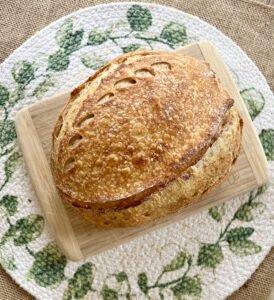 Everyone seems to be making sourdough these days. It certainly caught on as a craze during Covid, or maybe you picked it up later, like I did. Either way, making a beautiful loaf of bread is one of the most satisfying (and yummy) things you can bake. But I’d be lying if I said that sourdough bread isn’t daunting. The starter, supplies, let alone the steps… it’s hard to know where to start. And to make it worse, there are so many resources with conflicting information!
Everyone seems to be making sourdough these days. It certainly caught on as a craze during Covid, or maybe you picked it up later, like I did. Either way, making a beautiful loaf of bread is one of the most satisfying (and yummy) things you can bake. But I’d be lying if I said that sourdough bread isn’t daunting. The starter, supplies, let alone the steps… it’s hard to know where to start. And to make it worse, there are so many resources with conflicting information!
To combat this, we reached out to a few artisan bakers to get the low down on sourdough. Find out their tips and tricks for home bakers, as well as where to buy it locally. I’ve also included a few tips of my own, as someone who makes sourdough at home. And for all of our gluten-free friends, we’ve got info for you too!
Sophie Jeffery – Spread the Loaves

Sophie runs a sourdough microbakery, and is going from pop-up shops and markets, to her very own brick and mortar bakery! Here’s her take on sourdough:
“The secret ingredient to a great loaf of sourdough is time. Seriously! There’s no shortcut to getting a flavorful, well-proofed loaf. Your starter needs enough time to feed until it’s read to use, your dough needs plenty of time to rise, and you need enough time to practice. Be patient with yourself and your starter, and don’t give up if your first loaf doesn’t come out great. Go back to the basics and try again! You’ll nail it eventually.”
Her new bakery, Spread the Loaves, is located in Helotes at The Shops at Old Town Helotes. Her soft opening is February 24th, after which she will be open Saturdays only until mid-March. Don’t miss her grand opening in mid-to-late March, and keep an eye on her instagram for further updates!
Lovers Pizzeria

Dusty and Victoria are the owners and sole operators of Lovers Pizzeria, where they specialize in handmade NYC style slices and whole pizza pies, made with a real sourdough crust and locally sourced ingredients. If you’ve never had a sourdough pizza, put it on your must-eat bucket list! Here’s what they had to say:
“I think a tip for making sourdough pizza would be: your dough is only going to be as healthy as your culture is. Naturally leavened dough is so versatile in the sense that you can control flavor and texture by how you feed and maintain your starter. Knowing what you want and how to obtain a culture that will support the type of bread your are going for is key to executing your dream bread.”
Swing by their walk-up window, located at 1107 Roosevelt Ave., for delicious sourdough pizza! Grab a hand-mixed soda and homemade dessert while you’re there for the ultimate family date night.
My Tips & Tricks
Resources
My two favorite resources are @sourdough_explained on instagram, and Pro Home Cooks on YouTube. His YouTube video is worth the watch, and extremely helpful because it shows the whole process, in one place. The instagram page is London based, and is so great with troubleshooting problems and basic information, like feeding ratios, etc.
The Recipe
At its simplest form, sourdough bread is flour, water, starter, and salt. No yeast or sugar is required! The biggest mistake I made was thinking that I could sub out one kind of flour for another without changing the water ratio. Some flours, like wheat or einkorn, absorb more water than all purpose flour. If you have too much water in your recipe (which is called “the hydration”), your dough won’t be able to hold its shape no matter what you do. I also found that using recipes that call for 20% starter worked best for me, otherwise the proofing process would take days.
Feeding
Feed that starter!
Daily.
A good ratio is 1 part starter, to 4 parts water, and 4 parts flour. You’re looking for a pancake batter consistency; not too runny, not too thick. You can keep your starter in the fridge if you’re going to go days between feedings, which is helpful to know if you’ll be away for a few days at a time. Just know that you’ll have to do a few quick feeds to get it back to peak activity before you use it to bake bread again.
Supplies

Banneton proofing baskets and lames for scoring aren’t technically required, but I do love using them to make beautiful artisan loaves. A bench scraper is probably the most handy tool that I always recommend, and it can also be used when making biscuits, scones, pizza dough, etc. A kitchen scale is also a must, as most sourdough recipes are measured in grams. Lastly, a dutch oven or bread cloche. This is the best way to get a good rise and crisp crust as a home baker.
Gluten-Free Sourdough
I know very little about the gluten-free life, so I spoke with a friend who has been gluten free for 10 years. Here’s what she had to say:
“Making gluten-free sourdough is possible, and a very rewarding experience. You can make all of the same types of goodies as you would with traditional sourdough, but sans gluten; bread boules, sandwich bread, rolls, baguettes, pancakes, waffles, muffins, English muffins, cookies, and more! The possibilities are endless!”
“To get started you’ll need a good quality gluten-free sourdough culture. You cannot use a wheat-based sourdough starter for your gluten-free bread. You can either purchase your gluten-free culture from a reliable source, or get some from a friend. Cultures for Health has gluten-free sourdough starters, as well as a fantastic e-book to walk you through the procedures.”
“Be sure and use a single grain gluten-free flour, like organic brown rice flour. Decide what type of gluten-free flour you’d like to use (and stick with it). Stay away from all-purpose or measure-for-measure gluten-free flours as your base.”
“Finally, you need a good recipe! Gluten-free recipes are hard to develop on your own, but there are lots of recipes online and in the Cultures for Health gluten-free sourdough e-book. The dough produced is more like a thick batter, rather than an elastic and sticky dough. Given this, free forming breads can be a little difficult, but it is still doable.”
Check out her instagram for all things sourdough, gardening, and non-toxic living.
I think we can all agree that sourdough bread is delicious, whether you’re buying it or baking it yourself. And either way, it’s a win. You’re getting those digestive enzymes, cutting out the preservatives/artificial ingredients, and supporting local bakers. Remember that learning a new skill takes time, so give yourself some grace as you learn to bake sourdough.











